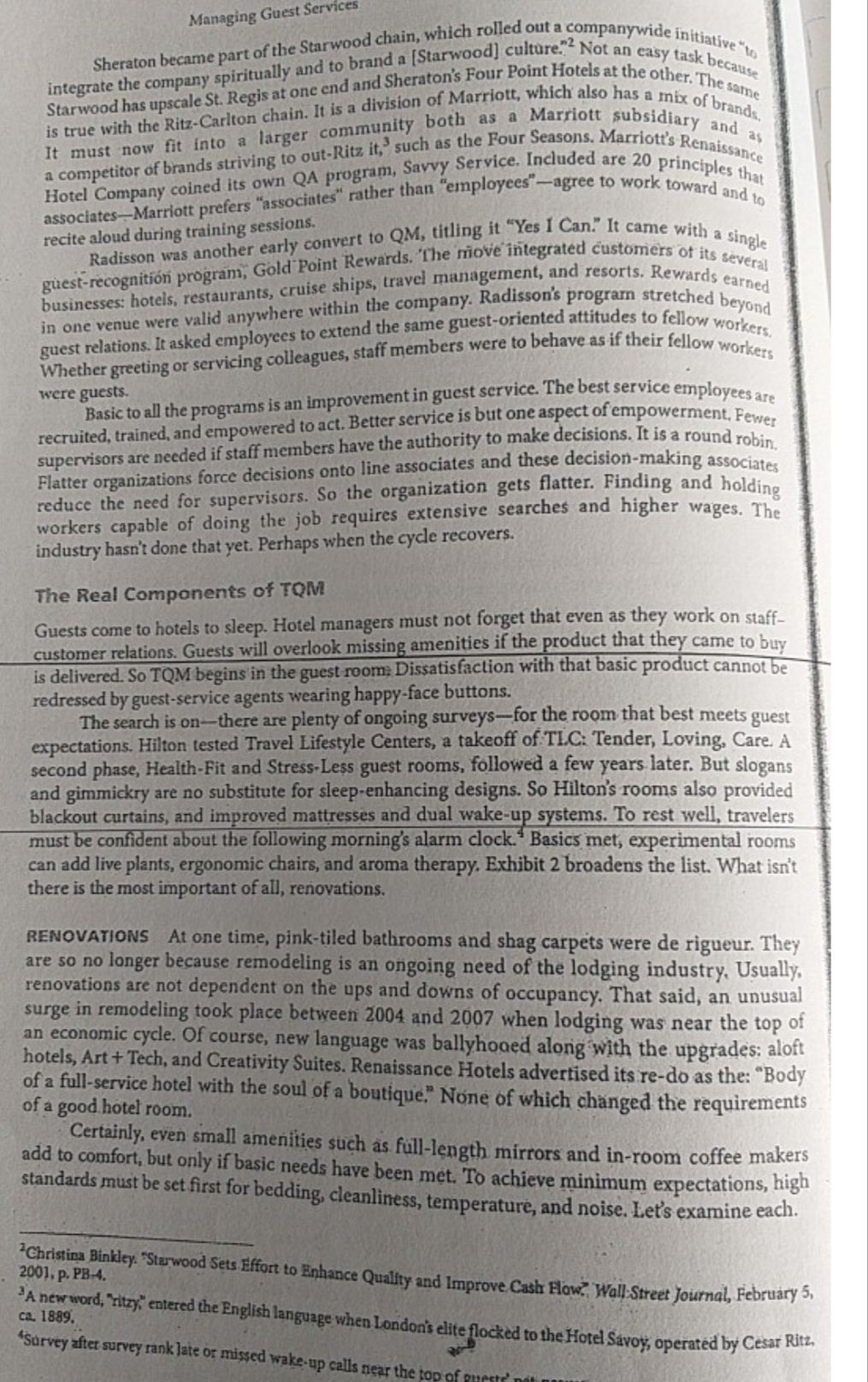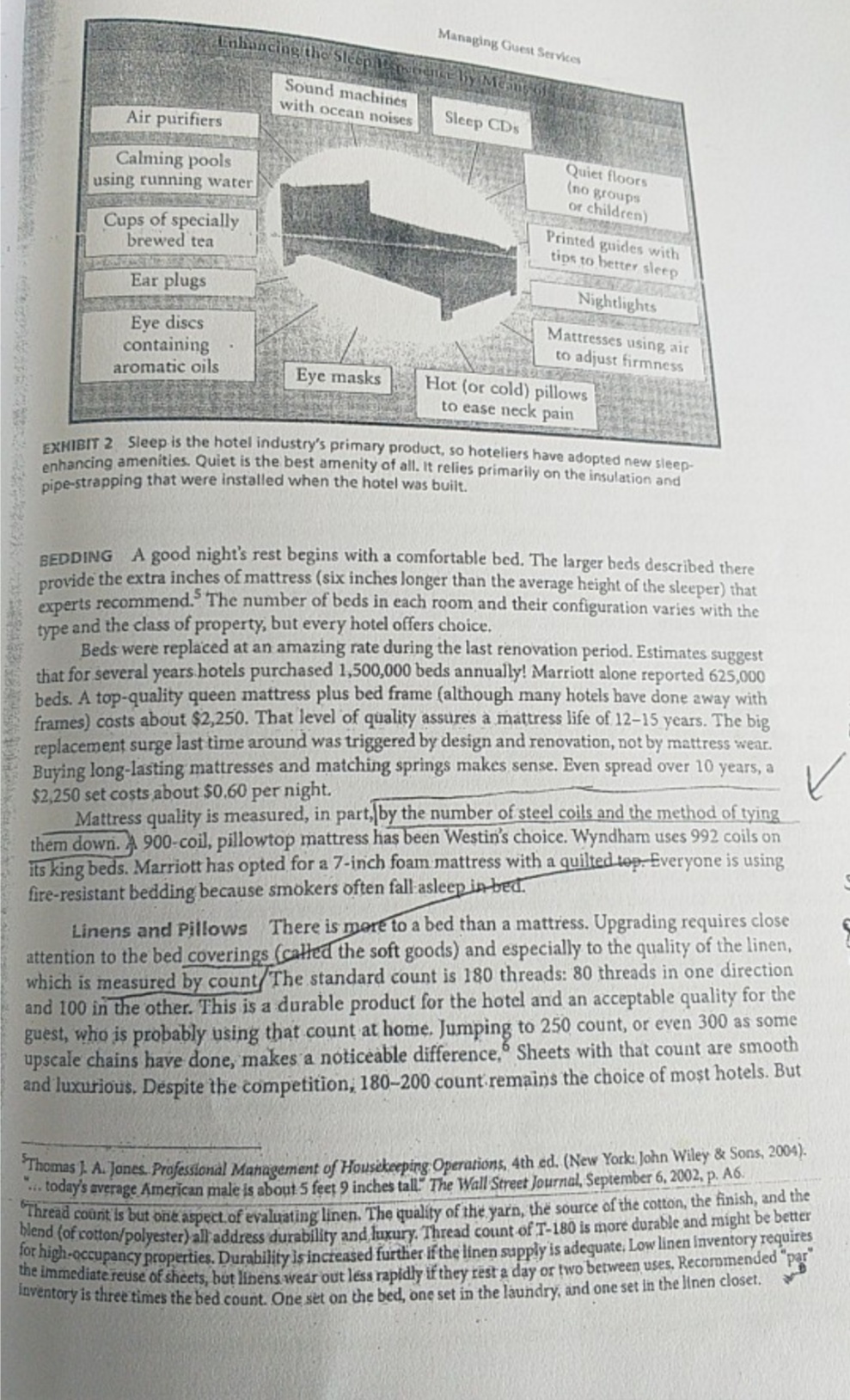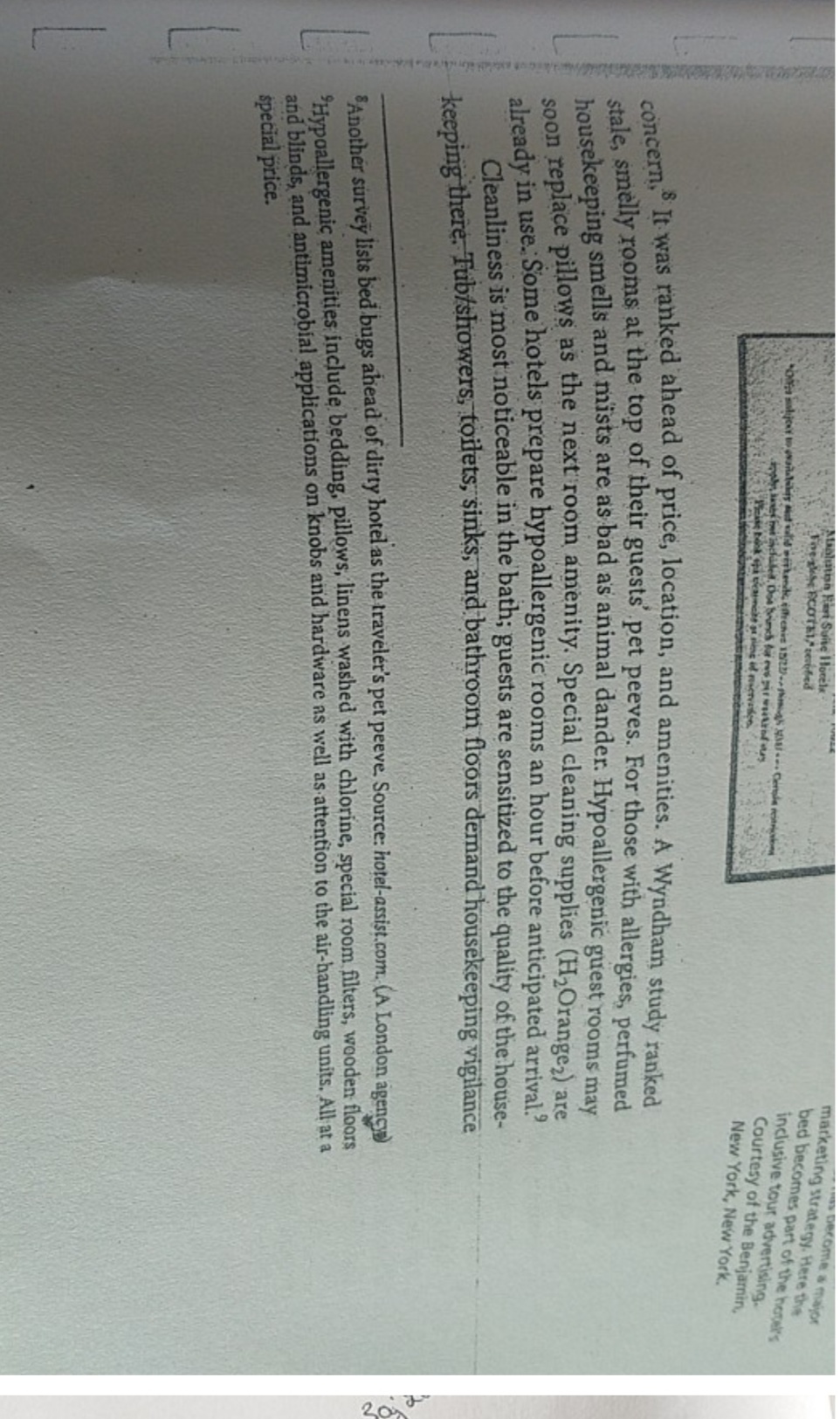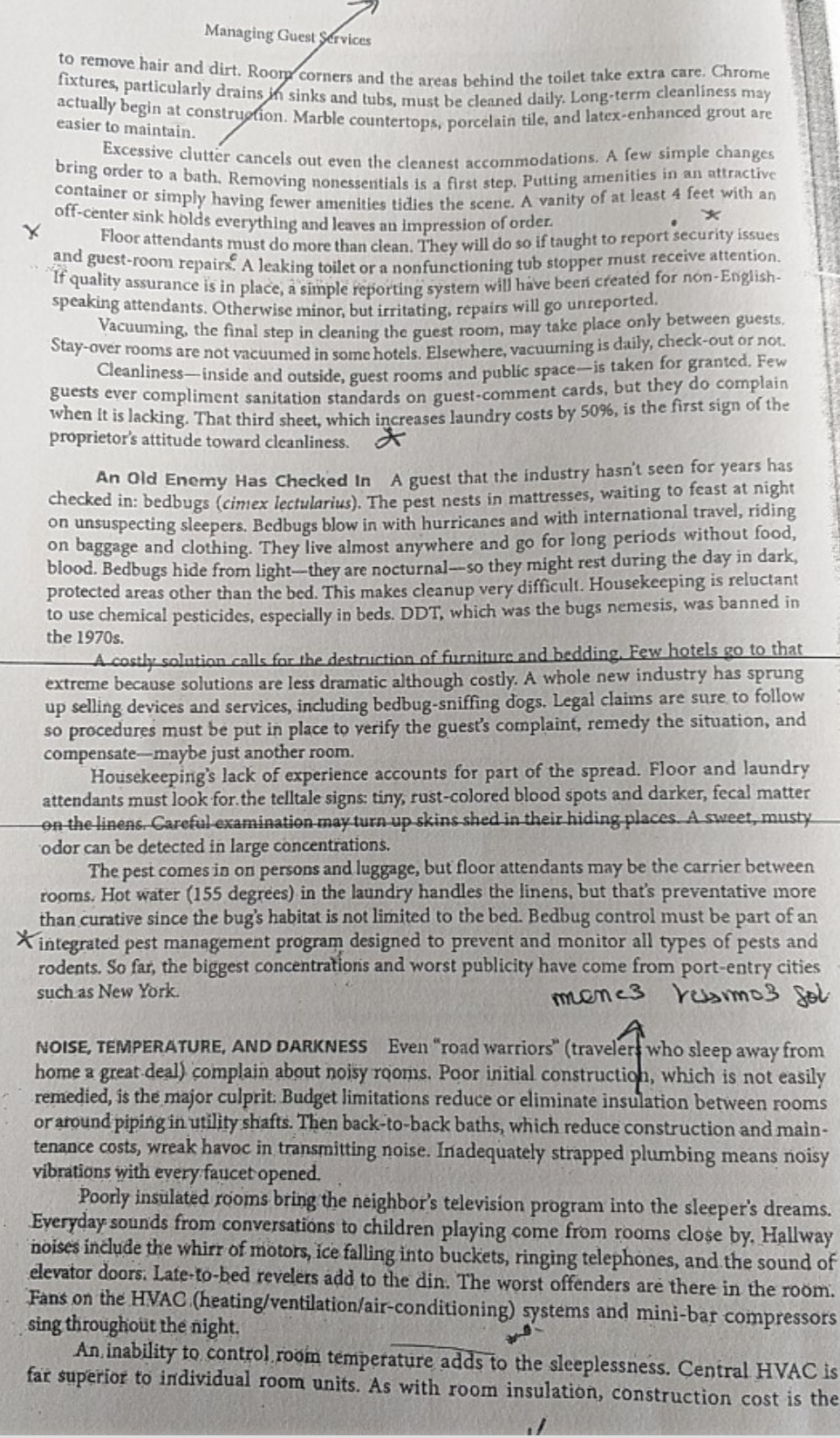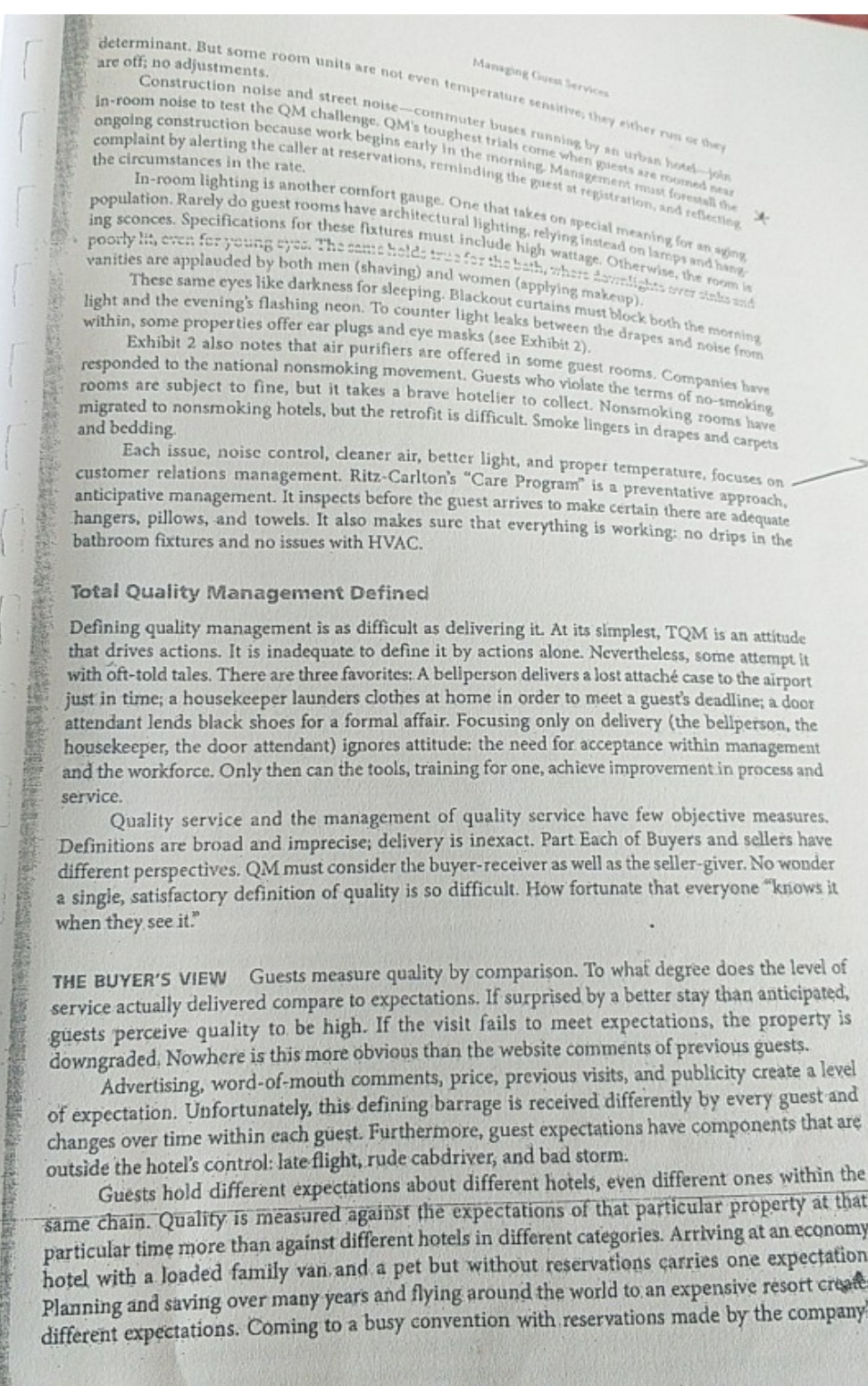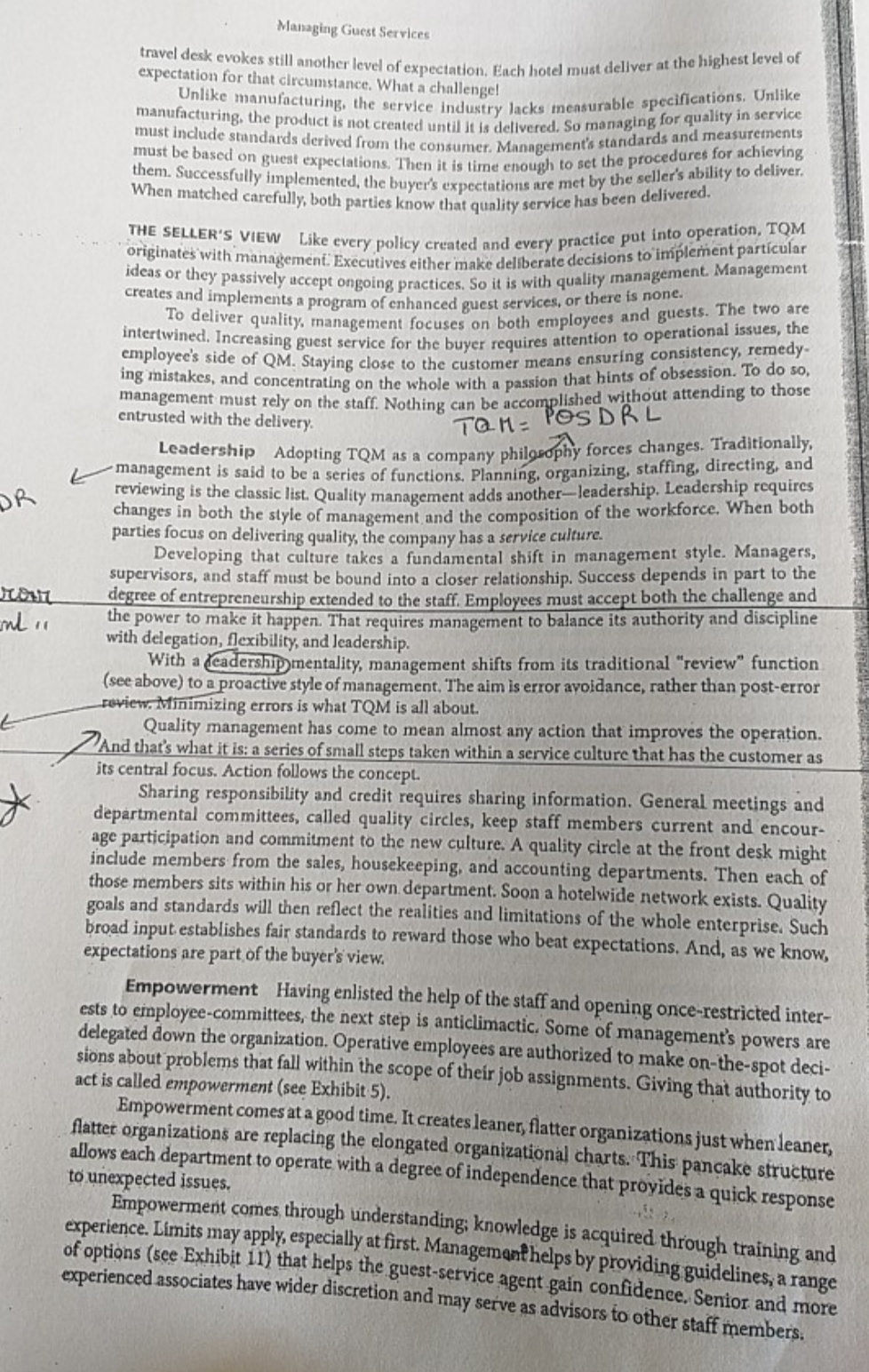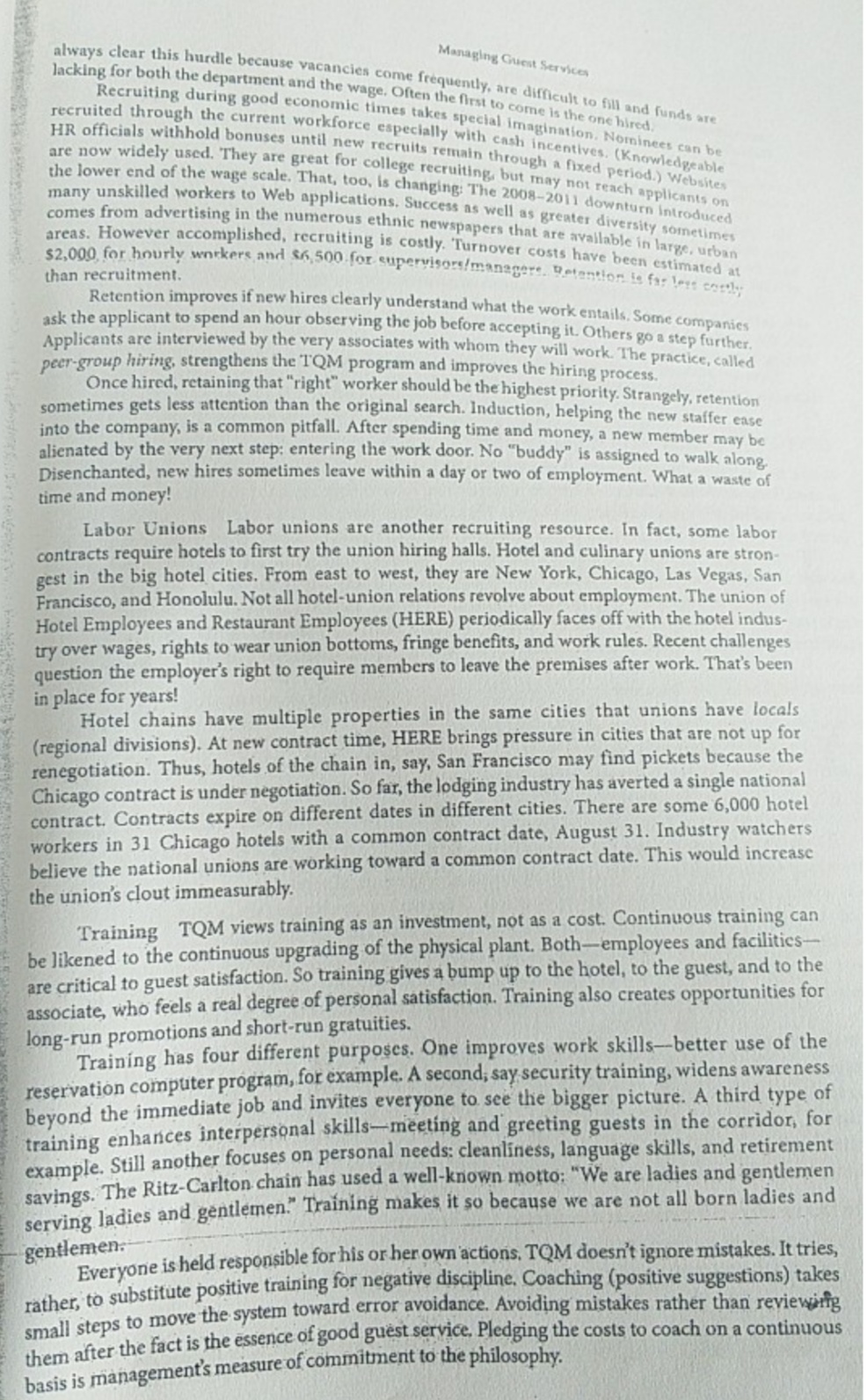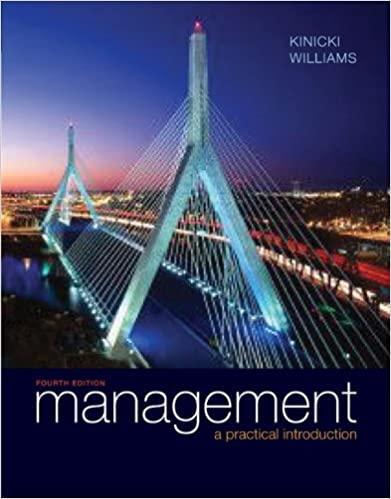Please explain clearly. Thank you.
Managing Guest Services Sheraton became part of the Starwood chain, which rolled out a companywide initiative" integrate the company spiritually and to brand a [Starwood] culture." Not an easy task became Starwood has upscale St. Regis at one end and Sheraton's Four Point Hotels at the other. The same is true with the Ritz-Carlton chain. It is a division of Marriott, which also has a mix of branhe it must now fit into a larger community both as a Marriott subsidiary and a competitor of brands striving to out-Ritz it, such as the Four Seasons, Marriott's Renaissance Hotel Company coined its own QA program, Savvy Service. Included are 20 principles that associates-Marriott prefers "associates" rather than "employees"-agree to work toward and to recite aloud during training sessions. _ Radisson was another early convert to QM, titling it "Yes I Can." It came with a single guest-recognition program, Gold Point Rewards. The move integrated customers of its several businesses: hotels, restaurants, cruise ships, travel management, and resorts. Rewards earned in one venue were valid anywhere within the company. Radisson's program stretched beyond guest relations. It asked employees to extend the same guest-oriented attitudes to fellow workers Whether greeting or servicing colleagues, staff members were to behave as if their fellow workers were guests. Basic to all the programs is an improvement in guest service. The best service employees are recruited, trained, and empowered to act. Better service is but one aspect of empowerment. Fewer supervisors are needed if staff members have the authority to make decisions. It is a round robin. Flatter organizations force decisions onto line associates and these decision-making associates reduce the need for supervisors. So the organization gets flatter. Finding and holding workers capable of doing the job requires extensive searches and higher wages. The industry hasn't done that yet. Perhaps when the cycle recovers. The Real Components of TOM Guests come to hotels to sleep. Hotel managers must not forget that even as they work on staff- customer relations. Guests will overlook missing amenities if the product that they came to buy is delivered. So TOM begins in the guest room; Dissatisfaction with that basic product cannot be redressed by guest-service agents wearing happy-face buttons. The search is on-there are plenty of ongoing surveys-for the room that best meets guest expectations. Hilton tested Travel Lifestyle Centers, a takeoff of TLC: Tender, Loving, Care. A second phase, Health-Fit and Stress-Less guest rooms, followed a few years later. But slogans and gimmickry are no substitute for sleep-enhancing designs. So Hilton's rooms also provided blackout curtains, and improved mattresses and dual wake-up systems. To rest well, travelers must be confident about the following morning's alarm clock.* Basics met, experimental rooms can add live plants, ergonomic chairs, and aroma therapy. Exhibit 2 broadens the list. What isn't there is the most important of all, renovations. RENOVATIONS At one time, pink-tiled bathrooms and shag carpets were de rigueur. They are so no longer because remodeling is an ongoing need of the lodging industry. Usually, renovations are not dependent on the ups and downs of occupancy, That said, an unusual surge in remodeling took place between 2004 and 2007 when lodging was near the top of an economic cycle. Of course, new language was ballyhooed along with the upgrades: aloft hotels, Art + Tech, and Creativity Suites. Renaissance Hotels advertised its re-do as the: "Body of a full-service hotel with the soul of a boutique." None of which changed the requirements of a good hotel room. Certainly, even small amenities such as full-length mirrors and in-room coffee makers add to comfort, but only if basic needs have been met. To achieve minimum expectations, high standards must be set first for bedding, cleanliness, temperature, and noise. Let's examine each. 2001, p. PB-4. 2Christina Binkley. "Starwood Sets Effort to Enhance Quality and Improve Cash Flow., Wall Street Journal, February 5, ca. 1889. A new word, "ritzy," entered the English language when London's elite flocked to the Hotel Savoy, operated by Cesar Ritz, Survey after survey rank late or missed wake-up calls near the top ofAEnhancing the Sleepies Managing Guest Services Sound machines Air purifiers with ocean noises Sleep CD's Calming pools using running water Quiet floors (no groups Cups of specially or children) brewed tea Printed guides with tips to better sleep Ear plugs Nightlights Eye discs containing Mattresses using air aromatic oils to adjust firmness Eye masks Hot (or cold) pillows to ease neck pain EXHIBIT 2 Sleep is the hotel industry's primary product, so hoteliers have adopted new sleep- enhancing amenities. Quiet is the best amenity of all. It relies primarily on the insulation and pipe-strapping that were installed when the hotel was built. BEDDING A good night's rest begins with a comfortable bed. The larger beds described there provide the extra inches of mattress (six inches longer than the average height of the sleeper) that experts recommend. The number of beds in each room and their configuration varies with the type and the class of property, but every hotel offers choice. Beds were replaced at an amazing rate during the last renovation period. Estimates suggest that for several years hotels purchased 1,500,000 beds annually! Marriott alone reported 625,000 beds. A top-quality queen mattress plus bed frame (although many hotels have done away with frames) costs about $2,250. That level of quality assures a mattress life of 12-15 years. The big replacement surge last time around was triggered by design and renovation, not by mattress wear. Buying long-lasting mattresses and matching springs makes sense. Even spread over 10 years, a $2,250 set costs about $0.60 per night. Mattress quality is measured, in part, by the number of steel coils and the method of tying them down. A 900-coil, pillowtop mattress has been Westin's choice. Wyndham uses 992 coils on its king beds. Marriott has opted for a 7-inch foam mattress with a quilted top. Everyone is using fire-resistant bedding because smokers often fall asleep in bed. Linens and Pillows There is more to a bed than a mattress. Upgrading requires close attention to the bed coverings (called the soft goods) and especially to the quality of the linen, which is measured by count/The standard count is 180 threads: 80 threads in one direction and 100 in the other. This is a durable product for the hotel and an acceptable quality for the guest, who is probably using that count at home. Jumping to 250 count, or even 300 as some upscale chains have done, makes a noticeable difference, Sheets with that count are smooth and luxurious. Despite the competition, 180-200 count remains the choice of most hotels. But Thomas J. A. Jones. Professional Management of Housekeeping Operations, 4th ed. (New York: John Wiley & Sons, 2004). "... today's average American male is about 5 feet 9 inches tall." The Wall Street Journal, September 6, 2002, p. A6. Thread count is but one aspect of evaluating linen. The quality of the yarn, the source of the cotton, the finish, and the blend (of cotton/polyester) all address durability and luxury. Thread count of T-180 is more durable and might be better for high-occupancy properties. Durability is increased further if the linen supply is adequate, Low linen Inventory requires inventory is three times the immediate reuse of sheets, but linens wear out less rapidly if they rest a day or two between uses, Recommended "par times the bed count. One set on the bed, one set in the laundry, and one set in the linen closet.art Suite Hotel become a major marketing strategy. Here the 1823-25 231 ... Cenla rem bed becomes part of the hotel's inclusive tour advertising. Courtesy of the Benjamin, New York, New York. concern, It was ranked ahead of price, location, and amenities. A Wyndham study ranked stale, smelly rooms at the top of their guests' pet peeves. For those with allergies, perfumed housekeeping smells and mists are as bad as animal dander. Hypoallergenic guest rooms may soon replace pillows as the next room amenity. Special cleaning supplies (H2Orangez) are already in use. Some hotels prepare hypoallergenic rooms an hour before anticipated arrival." Cleanliness is most noticeable in the bath; guests are sensitized to the quality of the house- keeping there. Tub/showers, toilets, sinks, and bathroom floors demand housekeeping vigilance Another survey lists bed bugs ahead of dirty hotel as the traveler's pet peeve. Source: hotel-assist.com. (A London agency) 20 0 'Hypoallergenic amenities include bedding, pillows, linens washed with chlorine, special room filters, wooden floors and blinds, and antimicrobial applications on knobs and hardware as well as attention to the air-handling units. All at a special price.Managing Guest Services to remove hair and dirt. Room corners and the areas behind the toilet take extra care. Chrome fixtures, particularly drains in sinks and tubs, must be cleaned daily. Long-term cleanliness may actually begin at construction. Marble countertops, porcelain tile, and latex-enhanced grout are easier to maintain. Excessive clutter cancels out even the cleanest accommodations. A few simple changes bring order to a bath. Removing nonessentials is a first step. Putting amenities in an attractive container or simply having fewer amenities tidies the scene. A vanity of at least 4 feet with an X off-center sink holds everything and leaves an impression of order. Floor attendants must do more than clean. They will do so if taught to report security issues and guest-room repairs. A leaking toilet or a nonfunctioning tub stopper must receive attention. If quality assurance is in place, a simple reporting system will have been created for non-English- speaking attendants. Otherwise minor, but irritating. repairs will go unreported. Vacuuming, the final step in cleaning the guest room, may take place only between guests. Stay-over rooms are not vacuumed in some hotels. Elsewhere, vacuuming is daily, check-out or not. Cleanliness-inside and outside, guest rooms and public space-is taken for granted. Few guests ever compliment sanitation standards on guest-comment cards, but they do complain when it is lacking. That third sheet, which increases laundry costs by 50%, is the first sign of the proprietor's attitude toward cleanliness. An Old Enemy Has Checked In A guest that the industry hasn't seen for years has checked in: bedbugs (cimex lectularius). The pest nests in mattresses, waiting to feast at night on unsuspecting sleepers. Bedbugs blow in with hurricanes and with international travel, riding on baggage and clothing. They live almost anywhere and go for long periods without food, blood. Bedbugs hide from light-they are nocturnal-so they might rest during the day in dark, protected areas other than the bed. This makes cleanup very difficult. Housekeeping is reluctant to use chemical pesticides, especially in beds. DDT, which was the bugs nemesis, was banned in the 1970s. A costly solution calls for the destruction of furniture and bedding. Few hotels go to that extreme because solutions are less dramatic although costly. A whole new industry has sprung up selling devices and services, including bedbug-sniffing dogs. Legal claims are sure to follow so procedures must be put in place to verify the guest's complaint, remedy the situation, and compensate-maybe just another room. Housekeeping's lack of experience accounts for part of the spread. Floor and laundry attendants must look for. the telltale signs: tiny, rust-colored blood spots and darker, fecal matter on the linens. Careful examination may turn up skins shed in their hiding places. A sweet, musty odor can be detected in large concentrations. The pest comes in on persons and luggage, but floor attendants may be the carrier between rooms. Hot water (155 degrees) in the laundry handles the linens, but that's preventative more than curative since the bug's habitat is not limited to the bed. Bedbug control must be part of an integrated pest management program designed to prevent and monitor all types of pests and rodents. So far, the biggest concentrations and worst publicity have come from port-entry cities such as New York. memes rebros sol NOISE, TEMPERATURE, AND DARKNESS Even "road warriors" (travelers who sleep away from home a great deal) complain about noisy rooms. Poor initial construction, which is not easily remedied, is the major culprit: Budget limitations reduce or eliminate insulation between rooms or around piping in utility shafts. Then back-to-back baths, which reduce construction and main- tenance costs, wreak havoc in transmitting noise. Inadequately strapped plumbing means noisy vibrations with every faucet opened. Poorly insulated rooms bring the neighbor's television program into the sleeper's dreams. Everyday sounds from conversations to children playing come from rooms close by, Hallway noises include the whirr of motors, ice falling into buckets, ringing telephones, and the sound of elevator doors. Late-to-bed revelers add to the din. The worst offenders are there in the room. Fans on the HVAC (heating/ventilation/air-conditioning) systems and mini-bar compressors sing throughout the night, An inability to control room temperature adds to the sleeplessness. Central HVAC is far superior to individual room units. As with room insulation, construction cost is theare off; no adjustments. Managing Guest Services determinant. But some room units are not even temperature sensitive; they either run or they Construction noise and street noise-commuter buses running by an urban hotel-join in-room noise to test the QM challenge. QM's toughest trials come when guests are roomed near ongoing construction because work begins early in the morning Management must forestall the the circumstances in the rate. complaint by alerting the caller at reservations, reminding the guest at registration, and reflecting In-room lighting is another comfort gauge. One that takes on special meaning for an aging, population. Rarely do guest rooms have architectural lighting, relying instead on lamps and hang ing sconces. Specifications for these fixtures must include high wattage. Otherwise, the room is poorly lit, even for young eyed The panic holds true for the bath, where Iowalight vanities are applauded by both men (shaving) and women (applying makeup). me eyes like darkness for sleeping. Blackout curtains must block both the morning light and the evening's flashing neon. To counter light leaks between the drapes and noise from within, some properties offer ear plugs and eye masks (see Exhibit 2). Exhibit 2 also notes that air purifiers are offered in some guest rooms. Companies have responded to the national nonsmoking movement. Guests who violate the terms of no-smoking rooms are subject to fine, but it takes a brave hotelier to collect. Nonsmoking rooms have and bedding. migrated to nonsmoking hotels, but the retrofit is difficult. Smoke lingers in drapes and carpets Each issue, noise control, cleaner air, better light, and proper temperature, focuses on customer relations management. Ritz Carlton's "Care Program" is a preventative approach, anticipative management. It inspects before the guest arrives to make certain there are adequate hangers, pillows, and towels. It also makes sure that everything is working: no drips in the bathroom fixtures and no issues with HVAC. Total Quality Management Defined Defining quality management is as difficult as delivering it. At its simplest, TOM is an attitude that drives actions. It is inadequate to define it by actions alone. Nevertheless, some attempt it with oft-told tales. There are three favorites; A bellperson delivers a lost attache case to the airport just in time; a housekeeper launders clothes at home in order to meet a guest's deadline; a door attendant lends black shoes for a formal affair. Focusing only on delivery (the bellperson, the housekeeper, the door attendant) ignores attitude: the need for acceptance within management and the workforce. Only then can the tools, training for one, achieve improvement in process and service. Quality service and the management of quality service have few objective measures. Definitions are broad and imprecise; delivery is inexact. Part Each of Buyers and sellers have different perspectives. QM must consider the buyer-receiver as well as the seller-giver. No wonder a single, satisfactory definition of quality is so difficult. How fortunate that everyone "knows it when they see it." THE BUYER'S VIEW Guests measure quality by comparison. To what degree does the level of service actually delivered compare to expectations. If surprised by a better stay than anticipated, guests perceive quality to be high. If the visit fails to meet expectations, the property is downgraded, Nowhere is this more obvious than the website comments of previous guests. Advertising, word-of-mouth comments, price, previous visits, and publicity create a level of expectation. Unfortunately, this defining barrage is received differently by every guest and changes over time within each guest. Furthermore, guest expectations have components that are outside the hotel's control: late flight, rude cabdriver, and bad storm. Guests hold different expectations about different hotels, even different ones within the same chain. Quality is measured against the expectations of that particular property at that particular time more than against different hotels in different categories. Arriving at an economy hotel with a loaded family van and a pet but without reservations carries one expectation Planning and saving over many years and flying around the world to an expensive resort create different expectations. Coming to a busy convention with reservations made by the companyManaging Guest Services travel desk evokes still another level of expectation. Each hotel must deliver at the highest level of expectation for that circumstance. What a challenge! Unlike manufacturing, the service industry lacks measurable specifications, Unlike manufacturing. the product is not created until it is delivered. So managing for quality in service must include standards derived from the consumer. Management's standards and measurements must be based on guest expectations. Then it is time enough to set the procedures for achieving them. Successfully implemented, the buyer's expectations are met by the seller's ability to deliver. When matched carefully, both parties know that quality service has been delivered. THE SELLER'S VIEW Like every policy created and every practice put into operation, TOM originates with management. Executives either make deliberate decisions to implement particular ideas or they passively accept ongoing practices. So it is with quality management. Management creates and implements a program of enhanced guest services, or there is none. To deliver quality, management focuses on uses on both employees and guests. The two are intertwined. Increasing guest service for the buyer requires attention to operational issues, the employee's side of QM. Staying close to the customer means ensuring consistency, remedy- ing mistakes, and concentrating on the whole with a passion that hints of obsession. To do so, management must rely on the staff. Nothing can be accomplished without attending to those entrusted with the delivery. TOM: POS DR Leadership Adopting TOM as a company philosophy forces changes. Traditionally, management is said to be a series of functions. Planning, organizing, staffing, directing, and OR reviewing is the classic list. Quality management adds another-leadership. Leadership requires changes in both the style of management and the composition of the workforce. When both parties focus on delivering quality, the company has a service culture. Developing that culture takes a fundamental shift in management style. Managers, supervisors, and staff must be bound into a closer relationship. Success depends in part to the degree of entrepreneurship extended to the staff. Employees must accept both the challenge and the power to make it happen. That requires management to balance its authority and discipline with delegation, flexibility, and leadership. With a Leadership mentality, management shifts from its traditional "review" function (see above) to a proactive style of management. The aim is error avoidance, rather than post-error review, Minimizing errors is what TOM is all about. Quality management has come to mean almost any action that improves the operation. ZAnd that's what it is: a series of small steps taken within a service culture that has the customer as its central focus. Action follows the concept. Sharing responsibility and credit requires sharing information. General meetings and departmental committees, called quality circles, keep staff members current and encour- age participation and commitment to the new culture. A quality circle at the front desk might include members from the sales, housekeeping, and accounting departments. Then each of those members sits within his or her own department. Soon a hotelwide network exists. Quality goals and standards will then reflect the realities and limitations of the whole enterprise. Such broad input establishes fair standards to reward those who beat expectations. And, as we know, expectations are part of the buyer's view. Empowerment Having enlisted the help of the staff and opening once-restricted inter- ests to employee-committees, the next step is anticlimactic, Some of management's powers are delegated down the organization. Operative employees are authorized to make on-the-spot deci- sions about problems that fall within the scope of their job assignments. Giving that authority to act is called empowerment (see Exhibit 5). Empowerment comes at a good time. It creates leaner, flatter organizations just when leaner, flatter organizations are replacing the elongated organizational charts. This pancake structure allows each department to operate with a degree of independence that provides a quick response to unexpected issues. Empowerment comes through understanding; knowledge is acquired through training and experience. Limits may apply, especially at first. Management helps by providing guidelines, a range of options (see Exhibit 11) that helps the guest-service agent gain confidence. Senior and more experienced associates have wider discretion and may serve as advisors to other staff members.Managing Guest Services hotels have adopted diversity programs to embrace the range of cultures. It seems contradictory, but the National Association for the Advancement of Colored People (NAACP) gives the hotel industry a low rank. 10 Hotels are searching for staff continuously. Employees, and that term includes supervisors and managers, come and go at a costly pace. Many workers are in dead-end jobs. Boredom and monotonous repetition are blunted temporarily by moving to another hotel even though the new job has the same tasks. The loss is especially costly if the individuals who move do so because they are motivated; the very people one wants to keep. Turnover at the lowest level of the organization, the spots where QM must shine, exceeds 200% annually in some jobs in some hotels. Said another way: Every employee is replaced twice each year! Less dramatic, but equally troublesome, rapid turnover also occurs among supervisors and managers. Turnover creates more turnover. Missing workers mean heavier loads for those remaining. [Discontent grows so establishing, maintaining, and improving TOM is put aside as resources are assigned to searching, finding, and replacing a turnstile staff. ] Retaining workers is smarter dollar-and-cent wise than replacing them. That is why reten- tion tools, long used in other industries, are finding their way into the lodging industry. Identifying and training qualified associates for upgrades is one step. Financial incentives another, and one with broader applications. Retirement plans, year-end bonuses, and employee stock options are relatively new concepts for this old industry. Financial incentives enable low-paid workers to build savings and remain with the company. Marriott adopted employee-participation plans years ago. An occasional dip in the economic cycle keeps staff at work and brings candidates to the employment office. But that is a temporary blip, not a long-term trend. QM demands a great deal from moderately paid personnel including those at the desk. Desk personnel are the first to see the arrival and the last to say goodbye. Although dollars and cents remain strong incentives, imaginative noncash rewards have a QM role. Others include cross-training, membership in quality circles, upgrade to a preferred shift, and language classes. Employee-of-the-month is a sure standby. It is more effective if it carries a cash stipend and other porks such as reserved parking or a newspaper ad. Some departments can accommo date flexible work hours, which may be the best perk for working parents. So, too, might be job sharing. Local hotels could form a consortium to accommodate working parents by operating a nursery school. It is costly, but it may hold workers, Cash incentives have a place for managers as well as associates. But since they are exempt from wage-and-hour laws, there is even a better reward, a day off. Long hours on the job cause hardships in personal life for many nonhourly (so-called exempt) workers. The best incentive might be an extra afternoon or a full day off. Good people at all levels is the measure of quality management. Finding and holding those persons is reflected in the salaries paid, the training offered, and the incentives rewarded. A hotel that concentrates on improving its human resources ensures the delivery of quality service. The effort begins with selecting and retaining the right persons. Selecting and Retaining the Right Persons Managing guest services requires enlisted and empowered employees. That means stretching backward to employment and forward to reten- tion. Quality service begins at selection. How else can the right person be at the right place when customer service relations require? The personnel office is TOM's launch site! (See Exhibit 1.) Selection-not hiring-is where good service begins. Just the expression, "You've been selected" changes the tone. Friendly, interactive associates who have the interest and ability to help will deliver better service than do more highly qualified technicians who lack those qualities. Just Wow! if the selection begins with an applicant who has both. The fact is, there are more guest complaints about employee attitude than about broken TV sets. "If you don't have the right people, then you are the dummy that hired them."1 Selecting the right person begins with finding the right pool of applicants. Personnel departments don't nies, not hotel companies.)' . .. " 10MGM Resorts International ranked 19 nationwide in an annual "Top-30 Companies for Diversity" list. (That is compa- "Horst Schulze, one-time president and COO, the Ritz-Carlton Hotel Company.Managing Guest Services always clear this hurdle because vacancies come frequently, are difficult to fill and funds are lacking for both the department and the wage. Often the first to come is the one hired. Recruiting during good economic times takes special imagination, Nominees can be recruited through the current workforce especially with cash incentives. (Knowledgeable HR officials withhold bonuses until new recruits remain through a fixed period.) Websites are now widely used. They are great for college recruiting, but may not reach applicants on the lower end of the wage scale. That, too, is changing: The 2008-2011 downturn introduced many unskilled workers to Web applications. Success as well as greater diversity sometimes comes from advertising in the numerous ethnic newspapers that are available in large, urban areas. However accomplished, recruiting is costly. Turnover costs have been estimated at than recruitment. $2,090, for hourly workers and $6,500 for supervisors/managers. Detention is far less costly Retention improves if new hires clearly understand what the work entails. Some companies ask the applicant to spend an hour observing the job before accepting it. Others go a step further. Applicants are interviewed by the very associates with whom they will work. The practice, called peer-group hiring, strengthens the TOM program and improves the hiring process. Once hired, retaining that "right" worker should be the highest priority. Strangely, retention sometimes gets less attention than the original search. Induction, helping the new staffer ease into the company, is a common pitfall. After spending time and money, a new member may be alienated by the very next step: entering the work door. No "buddy" is assigned to walk along time and money! Disenchanted, new hires sometimes leave within a day or two of employment. What a waste of Labor Unions Labor unions are another recruiting resource. In fact, some labor contracts require hotels to first try the union hiring halls. Hotel and culinary unions are stron- gest in the big hotel cities. From east to west, they are New York, Chicago, Las Vegas, San Francisco, and Honolulu. Not all hotel-union relations revolve about employment. The union of Hotel Employees and Restaurant Employees (HERE) periodically faces off with the hotel indus- try over wages, rights to wear union bottoms, fringe benefits, and work rules. Recent challenges question the employer's right to require members to leave the premises after work. That's been in place for years! Hotel chains have multiple properties in the same cities that unions have locals (regional divisions). At new contract time, HERE brings pressure in cities that are not up for renegotiation. Thus, hotels of the chain in, say, San Francisco may find pickets because the Chicago contract is under negotiation. So far, the lodging industry has averted a single national contract. Contracts expire on different dates in different cities. There are some 6,000 hotel workers in 31 Chicago hotels with a common contract date, August 31. Industry watchers believe the national unions are working toward a common contract date. This would increase the union's clout immeasurably. Training TOM views training as an investment, not as a cost. Continuous training can be likened to the continuous upgrading of the physical plant. Both-employees and facilities- are critical to guest satisfaction. So training gives a bump up to the hotel, to the guest, and to the associate, who feels a real degree of personal satisfaction. Training also creates opportunities for long-run promotions and short-run gratuities. Training has four different purposes. One improves work skills-better use of the reservation computer program, for example. A second, say security training, widens awareness beyond the immediate job and invites everyone to see the bigger picture. A third type of training enhances interpersonal skills-meeting and greeting guests in the corridor, for example. Still another focuses on personal needs: cleanliness, language skills, and retirement savings. The Ritz-Carlton chain has used a well-known motto: "We are ladies and gentlemen serving ladies and gentlemen." Training makes it so because we are not all born ladies and gentlemen. Everyone is held responsible for his or her own actions, TOM doesn't ignore mistakes. It tries, rather, to substitute positive training for negative discipline, Coaching (positive suggestions) takes small steps to move the system toward error avoidance. Avoiding mistakes rather than reviewing them after the fact is the essence of good guest service. Pledging the costs to coach on a continuous basis is management's measure of commitment to the philosophy
